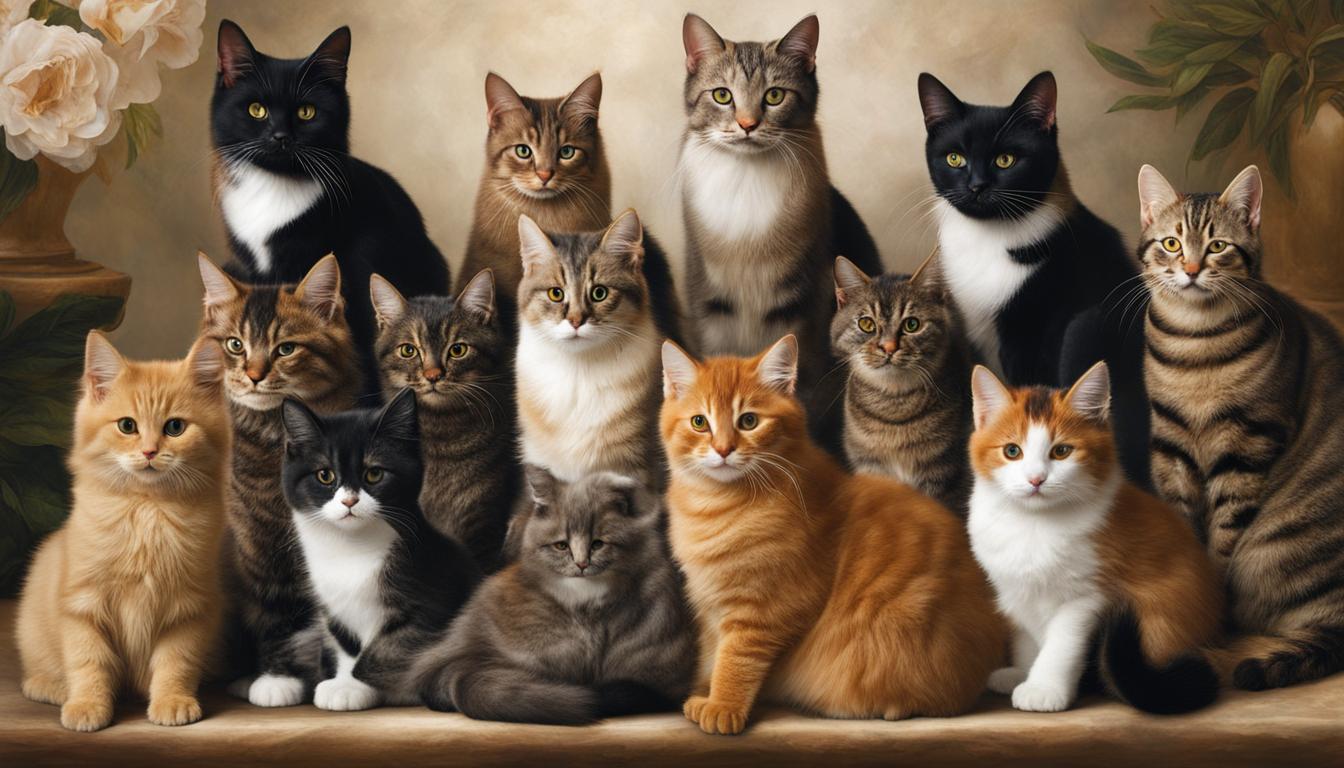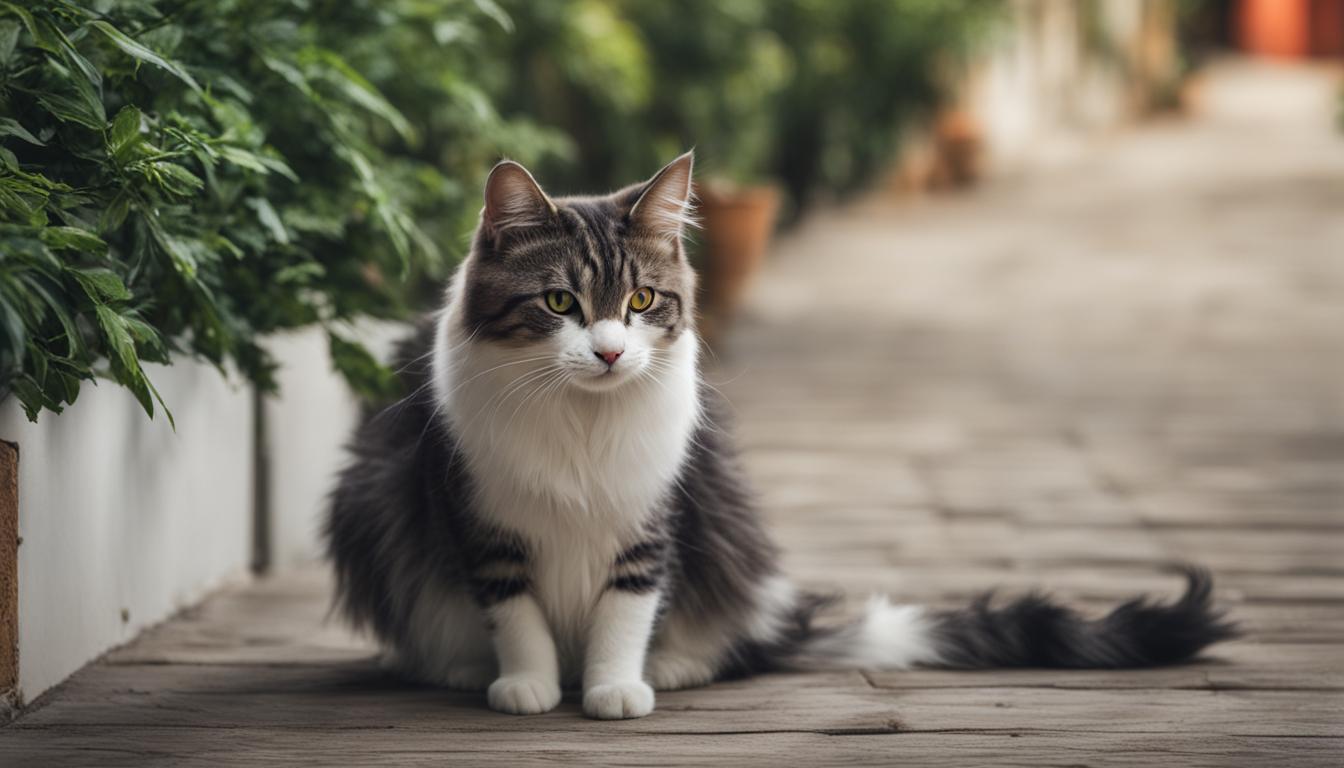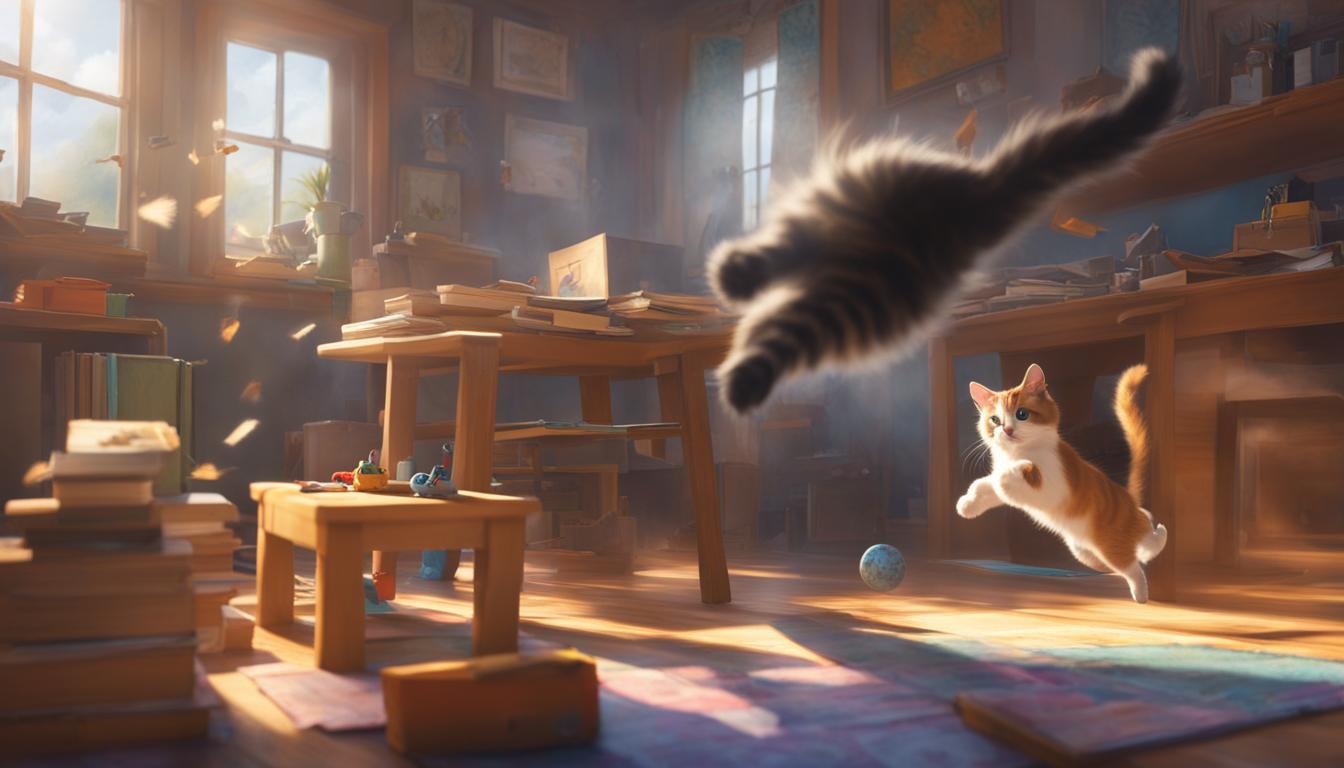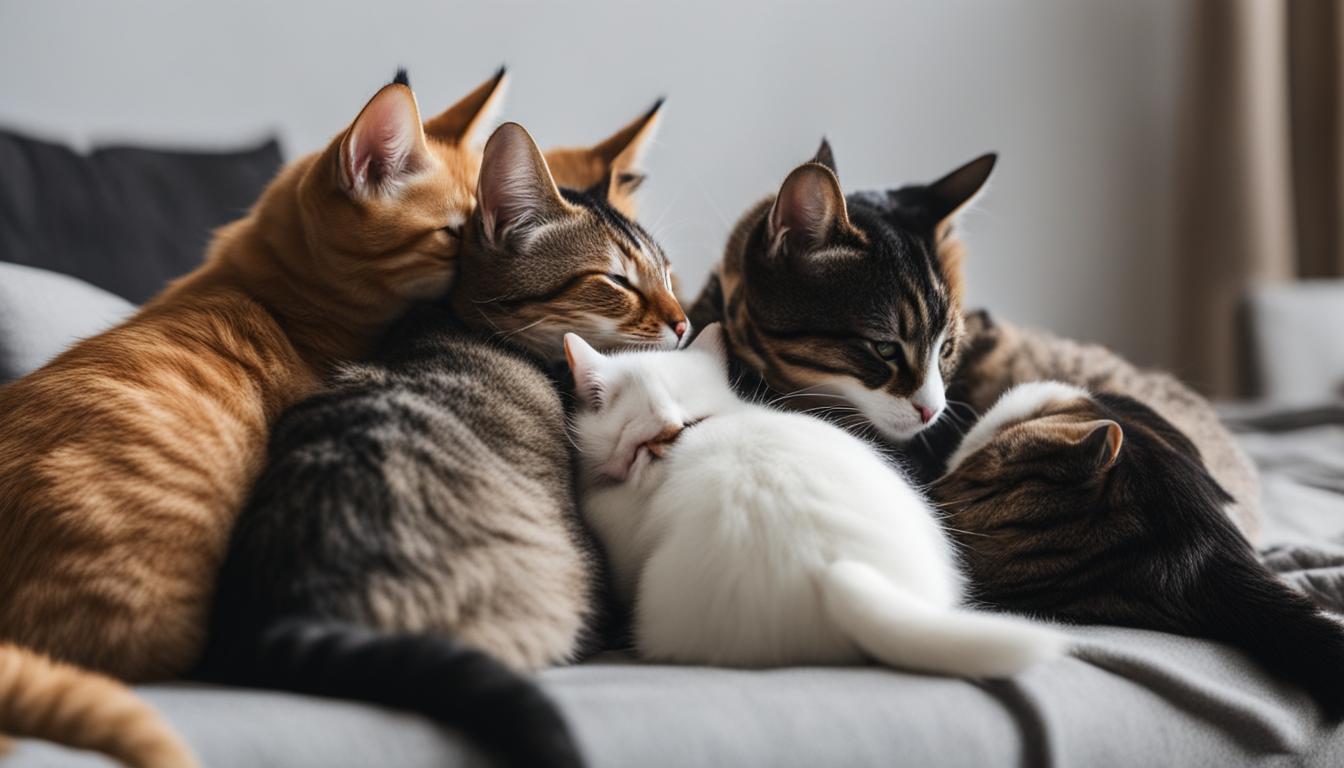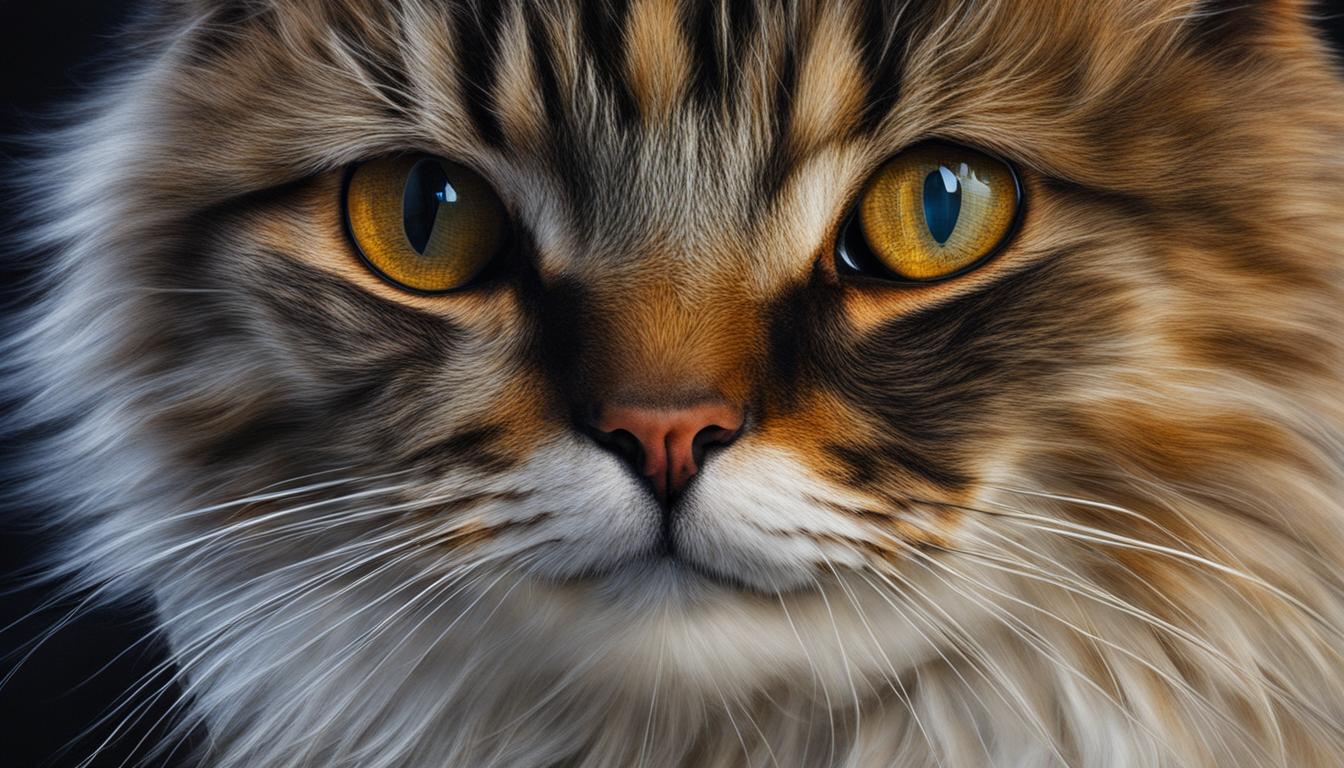In my quest to understand the intricate dynamics of multi-cat households, I can’t help but marvel at the complexity of social hierarchies that exist among our feline friends. With approximately 70 million pet cats in Canada and the US alone, it’s clear that many households have embraced the joys and challenges of managing multiple cats under one roof.
While cats are descendants of largely solitary wildcats, they have adapted remarkably well to group living in human settlements. However, the impact of housing cats together in multi-cat households is still a subject of ongoing exploration. Inter-cat conflict is a common issue in these households, which can lead to stress, health problems, and behavioral issues.
As I dig deeper into the research, it becomes apparent that various factors influence the cat-cat relationship in multi-cat households. From resource provision to outdoor access, and even the individual characteristics of each cat, there’s so much to consider when striving to create a harmonious social order. So, let’s embark on this curious journey together as we unravel the mysteries behind managing multi-cat households and delve into the fascinating world of dominant behavior in these dynamic feline communities.
Key Takeaways:
- Understanding the social dynamics of multi-cat households is essential for managing their well-being.
- Providing multiple, well-distributed resources can help reduce conflicts among cats.
- Limiting outdoor access and considering factors like neuter status and relatedness can influence social dynamics.
- Establishing a clear hierarchy within the group helps reduce conflicts and promotes a harmonious environment.
- Consulting with professionals can offer valuable guidance in managing multi-cat households.
Factors Affecting the Cat-Cat Relationship in Multi-Cat Households
Cats in multi-cat households establish a hierarchy or pecking order, with dominant and submissive cats. This hierarchy helps reduce conflicts by establishing clear roles within the group. The social interactions and relationships between cats in a multi-cat household can be influenced by various factors. These include the cats’ spay/neuter status, age, relatedness, outdoor access, and aggression towards people or other animals in the home. Factors such as having a large age gap between cats, unrelated cats, and limited resource areas (e.g., litter boxes and feeding areas) have been associated with a more negative cat-cat relationship. Understanding these factors can help cat owners in managing and improving the social dynamics in their multi-cat households.
Integrating New Cats into Multi-Cat Homes
Introducing a new cat to an existing multi-cat household can be a delicate process. It is important to allow for a gradual introduction, starting with scent exchanges and visual introductions before progressing to supervised interactions. Providing separate spaces and resources for the new cat initially helps them acclimate without triggering territorial behaviors from the resident cats. Slowly integrating the cats with supervised interactions and gradually increasing their time together can prevent conflicts and aid in the establishment of a positive cat-cat relationship.
“Managing conflicts and promoting positive social interactions are essential for maintaining a harmonious environment in multi-cat households.”
Resolving Conflicts in Multi-Cat Homes
Conflicts between cats in multi-cat households can arise due to various reasons, such as resource guarding, competition for attention, or misunderstandings in communication. It is important to monitor for signs of stress or aggression and address conflicts promptly. Providing an abundance of resources, such as multiple litter boxes, feeding areas, and scratching posts, can help reduce the likelihood of resource guarding and minimize conflicts. Environmental modifications, such as creating vertical spaces and hiding spots, can also provide cats with opportunities to retreat and de-escalate tense situations. In cases of persistent conflicts, consulting with a veterinarian or animal behaviorist can provide valuable insights and guidance for resolving the issues.
By understanding the factors influencing the cat-cat relationship and employing strategies to integrate new cats and manage conflicts, cat owners can create a harmonious and peaceful environment in their multi-cat households. Nurturing positive social interactions and providing ample resources contribute to the overall well-being and happiness of the cats, fostering a thriving feline community.

Benefits of Multi-Cat Households
Living in a multi-cat household offers numerous benefits for both cats and humans. Cats are social animals, and having feline companions fulfills their need for companionship and social interaction. Cats in multi-cat households engage in activities such as grooming, playing, and cuddling, which help reduce loneliness and stress. They form close bonds with each other, creating their own little community.
The diverse personalities of cats in multi-cat households provide entertainment and a deeper understanding of feline behavior. Observing their interactions and social dynamics can be fascinating, and it allows us to appreciate the complexity of their relationships. Additionally, multi-cat households can be particularly beneficial for socializing kittens or newly adopted cats. Older, more experienced cats can serve as role models and teach younger ones appropriate behavior and household routines.
Multi-cat households also provide enrichment and stimulation for cats. Cats often engage in playful and interactive behaviors with each other, reducing boredom and stress. They have companions to explore and play with, which helps keep them mentally and physically stimulated. For humans, having multiple cats brings companionship, comfort, and entertainment, enhancing their overall quality of life.
| Benefits of Multi-Cat Households |
|---|
| Cats fulfill their need for companionship and social interaction. |
| Cats engage in grooming, playing, and cuddling, reducing loneliness and stress. |
| Cats form close bonds and create their own little community. |
| Observing the interactions provides entertainment and understanding of feline behavior. |
| Older cats can teach younger ones appropriate behavior and routines. |
| Multi-cat households reduce boredom and stress for cats. |
| Companionship, comfort, and entertainment for humans. |
Overall, the benefits of multi-cat households outweigh the challenges. However, it is important to consider the individual needs and personalities of the cats when managing a multi-cat household. Providing appropriate resources, monitoring interactions, and addressing conflicts promptly are crucial in creating a harmonious environment for both cats and humans.
Challenges of Managing Multi-Cat Households
Managing a multi-cat household can be a rewarding experience, but it also comes with its fair share of challenges. One common challenge is litter box management. Cats are known for their cleanliness, and ensuring that each cat has access to a clean and properly maintained litter box is crucial. In multi-cat households, it’s recommended to have one litter box per cat, plus an extra one. This helps prevent territorial disputes and reduces stress-related behaviors such as inappropriate elimination.
Resolving conflicts between cats is another challenge that cat owners may face in a multi-cat household. Cats are territorial animals, and conflicts can arise over resources such as food, water, and sleeping areas. To minimize conflicts, it’s important to provide multiple feeding and resting areas throughout the house. Additionally, monitoring the cats’ behavior and intervening if necessary can help prevent escalating conflicts.
Managing a multi-cat household requires attention to providing adequate resources, addressing conflicts promptly, and promoting positive social interactions.
Another challenge that cat owners may encounter is ensuring that each cat gets proper attention and care. Cats are individuals with unique personalities and needs, and it’s important to provide individualized attention and enrichment for each cat. This can be achieved through interactive play sessions, environmental enrichment, and regular one-on-one bonding time.
Table: Common Challenges of Multi-Cat Households
| Challenge | Solution |
|---|---|
| Litter box management | Provide one litter box per cat, plus an extra one. Ensure regular cleaning and proper maintenance. |
| Resolving conflicts | Provide multiple feeding and resting areas. Monitor behavior and intervene if conflicts arise. |
| Individualized attention | Engage in interactive play sessions, provide environmental enrichment, and spend one-on-one time with each cat. |
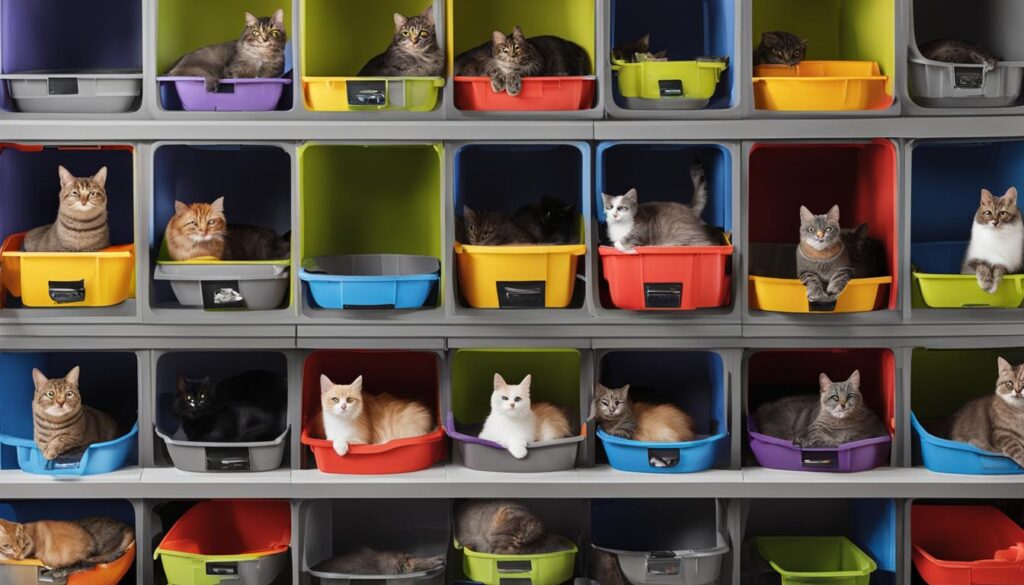
Managing a multi-cat household may have its challenges, but with proper care, attention, and understanding, it is possible to create a harmonious and thriving environment for all the cats in the home.
Cat-Cat Relationship in Two-Cat Households
Two-cat households are a popular choice among cat owners. Understanding the dynamics of the cat-cat relationship in these households is crucial for creating a harmonious living environment for our feline friends. In two-cat households, cats establish their own unique social order and interact with each other in various ways, influenced by factors such as their personalities, age, and relatedness.
Research suggests that the cat-cat relationship in two-cat households can be affected by both positive and negative factors. Cats that are both spayed females, adult or mature, and have a large age gap between them may experience a more negative relationship. Additionally, unrelated cats and cats with a history of aggression towards people or other animals in the home may also have a more challenging dynamic.
To foster a positive cat-cat relationship in two-cat households, it is important to provide multiple resources and spaces for each cat. This includes having separate litter boxes, feeding areas, and resting spots to avoid competition and territorial disputes. Creating an enriched environment with interactive toys and scratching posts can also encourage positive interactions and help alleviate boredom or stress.
Table: Factors Influencing Cat-Cat Relationship in Two-Cat Households
| Factors | Impact on Cat-Cat Relationship |
|---|---|
| Spay/neuter status | Both spayed females may lead to a more negative relationship |
| Age | A large age gap between cats may influence the relationship |
| Relatedness | Unrelated cats may have a more challenging dynamic |
| Aggression | Cats with a history of aggression may have a more difficult relationship |
By understanding the factors that impact the cat-cat relationship in two-cat households and making the necessary adjustments to the environment, we can promote a positive and peaceful coexistence between our feline companions. Regular monitoring of their interactions and addressing any conflicts promptly can also contribute to maintaining a harmonious living environment.
Tips for Managing Multi-Cat Households
Managing a multi-cat household can be both challenging and rewarding. Here are some tips to help maintain social order and harmony in your multi-cat home:
- Introduce new cats gradually: When bringing a new cat into your home, it’s important to introduce them to the resident cats slowly and in a controlled manner. This allows the cats to adjust to each other’s presence and establish their hierarchy.
- Provide separate spaces and resources: Cats need their own individual spaces and resources to feel secure. Make sure each cat has access to separate feeding areas, litter boxes, and comfortable resting spots.
- Promote positive interactions: Encourage positive social interactions between your cats by providing opportunities for play and bonding. Interactive toys, scratching posts, and climbing trees can help stimulate their natural instincts and reduce tension.
- Address conflicts promptly: Monitor your cats for any signs of aggression or territorial behavior. If conflicts arise, intervene calmly and redirect their attention. Seek professional guidance if necessary to resolve any ongoing issues.
By following these tips, you can create a harmonious environment where your cats can coexist happily.
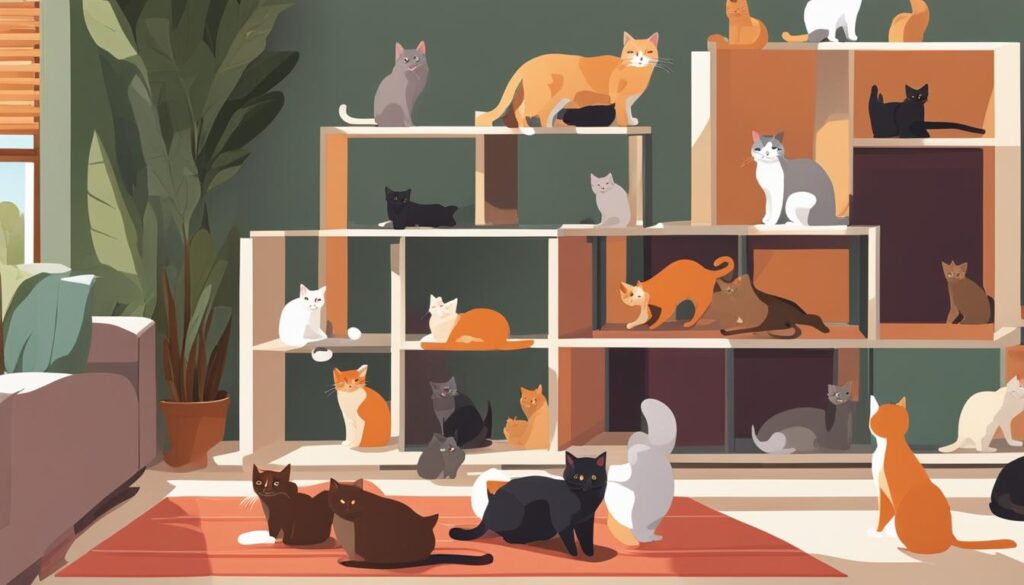
The Impact of Social Order on Cat Well-being
In multi-cat households, the social order and dynamics among cats have a significant impact on their overall well-being. The interactions and relationships between cats can greatly influence their stress levels, behavior, and overall happiness. It is crucial for cat owners to understand the importance of social order and take steps to promote a positive cat-cat relationship.
Cat welfare in multi-cat households depends on several factors, including resource availability, territory management, and the prevention of conflicts. Providing enough resources, such as litter boxes, feeding areas, and scratching posts, for each cat can help prevent resource guarding and reduce stress. Additionally, cats feel more secure and satisfied when they have designated areas to retreat to, such as cozy beds or hiding spots.
“Cats in multi-cat households engage in grooming, play, and cuddling, which helps reduce loneliness and stress.”
Regular monitoring of cat-cat interactions is crucial to identify and address any conflicts promptly. Aggression, excessive hiding, or changes in eating or elimination habits can be signs of underlying conflicts or stress. Early intervention and behavior modification techniques, such as positive reinforcement training or environmental modifications, can help resolve conflicts and improve the social dynamics in multi-cat households.
| Factors Affecting Cat Well-being in Multi-Cat Households | Impact on Cat Well-being |
|---|---|
| Positive social interactions | Improved mental stimulation and reduced stress |
| Resource availability | Prevention of resource guarding and reduced competition |
| Conflict resolution | Reduced stress and improved overall well-being |
| Territory management | Reduced territorial disputes and increased sense of security |
Creating a harmonious social order in multi-cat households not only benefits the cats but also enhances the bond between cats and their human companions. When cats feel secure and content, they are more likely to exhibit positive behaviors and form stronger connections with their owners. By understanding the impact of social order on cat well-being and taking appropriate measures to promote a positive cat-cat relationship, cat owners can create a thriving and happy environment for their furry friends.
Conclusion
So, there you have it – the ins and outs of managing a multi-cat household and understanding the intricate cat-cat relationships. Maintaining a positive social order is the key to a thriving and harmonious environment for your feline companions.
By providing well-distributed resources, carefully introducing new cats, and promoting positive social interactions, you can minimize conflicts and ensure the well-being of all your furry friends. Remember to monitor their interactions, address conflicts promptly, and seek professional guidance if needed.
Managing multi-cat households may have its challenges, but the joy, companionship, and entertainment that come with it make it all worthwhile. So, embrace the paw-some world of multi-cat living and enjoy the unique dynamics that your feline friends bring to your home!
FAQ
What is the impact of housing cats together in multi-cat households?
Housing cats together in multi-cat households can result in inter-cat conflict, leading to stress, health problems, and behavioral issues.
What factors can influence the cat-cat relationship in multi-cat households?
Factors such as resource provision, outdoor access, and cat characteristics can influence the cat-cat relationship in multi-cat households.
What are the benefits of having a multi-cat household?
Cats in multi-cat households fulfill their need for companionship and social interaction, engage in grooming, play, and cuddling, and form close bonds with each other. Multi-cat households also provide entertainment and companionship for humans.
What challenges can arise in multi-cat households?
Challenges in multi-cat households include introducing new cats, providing enough resources, monitoring for conflicts, and resolving conflicts through behavioral interventions and environmental modifications.
How does the cat-cat relationship differ in two-cat households?
Factors such as spay/neuter status, age, relatedness, outdoor access, and aggression can influence the cat-cat relationship in two-cat households.
What tips can help in managing multi-cat households?
Tips for managing multi-cat households include gradual introductions, providing adequate resources, regular playtime and enrichment, monitoring cat-cat interactions, and seeking professional guidance when needed.
How does social order impact the well-being of cats in multi-cat households?
A positive social order promotes the well-being of cats in multi-cat households, while conflicts and inadequate social interactions can lead to stress, health issues, and behavioral problems.
What is the conclusion regarding social order in multi-cat households?
Managing multi-cat households requires attention to various factors, such as resource provision, conflict resolution, and promoting positive social interactions, to ensure a harmonious environment for both cats and humans.

